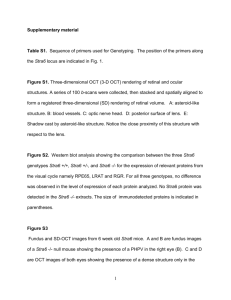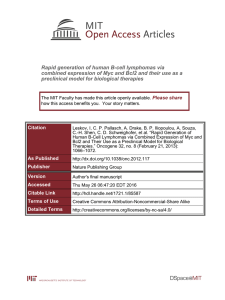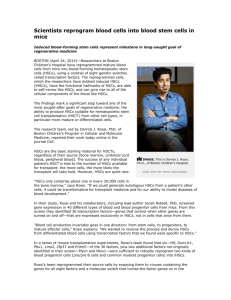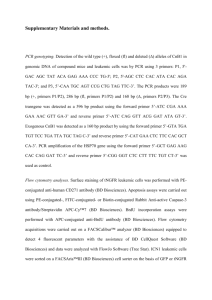Supplementary data (docx 118K)
advertisement
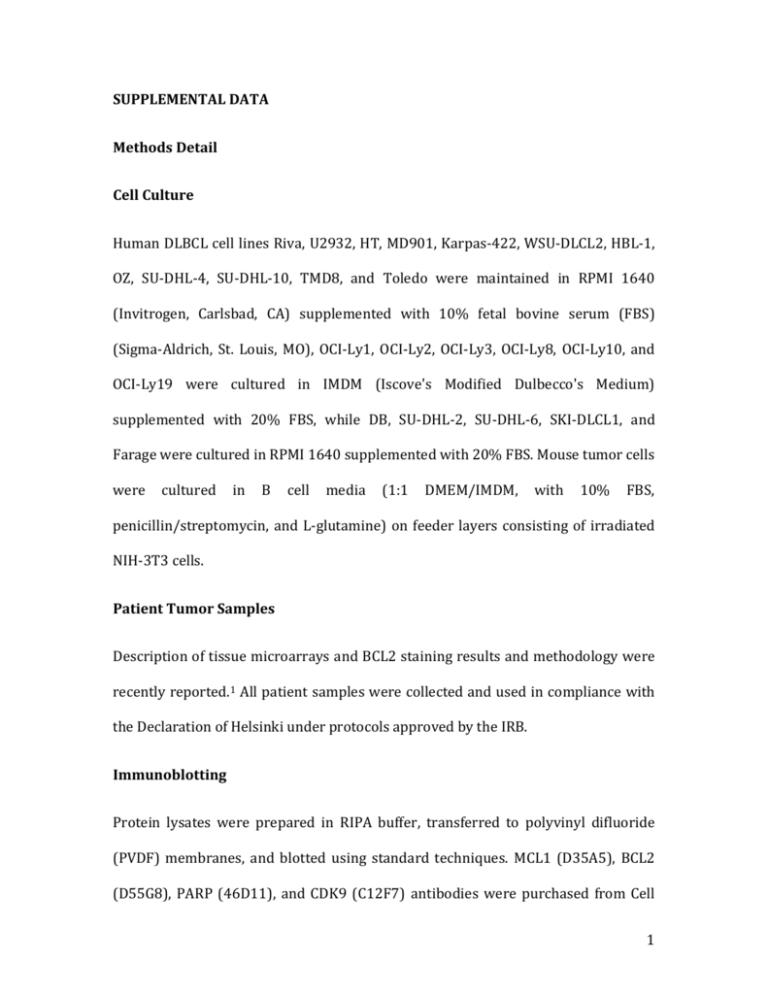
SUPPLEMENTAL DATA Methods Detail Cell Culture Human DLBCL cell lines Riva, U2932, HT, MD901, Karpas-422, WSU-DLCL2, HBL-1, OZ, SU-DHL-4, SU-DHL-10, TMD8, and Toledo were maintained in RPMI 1640 (Invitrogen, Carlsbad, CA) supplemented with 10% fetal bovine serum (FBS) (Sigma-Aldrich, St. Louis, MO), OCI-Ly1, OCI-Ly2, OCI-Ly3, OCI-Ly8, OCI-Ly10, and OCI-Ly19 were cultured in IMDM (Iscove's Modified Dulbecco's Medium) supplemented with 20% FBS, while DB, SU-DHL-2, SU-DHL-6, SKI-DLCL1, and Farage were cultured in RPMI 1640 supplemented with 20% FBS. Mouse tumor cells were cultured in B cell media (1:1 DMEM/IMDM, with 10% FBS, penicillin/streptomycin, and L-glutamine) on feeder layers consisting of irradiated NIH-3T3 cells. Patient Tumor Samples Description of tissue microarrays and BCL2 staining results and methodology were recently reported.1 All patient samples were collected and used in compliance with the Declaration of Helsinki under protocols approved by the IRB. Immunoblotting Protein lysates were prepared in RIPA buffer, transferred to polyvinyl difluoride (PVDF) membranes, and blotted using standard techniques. MCL1 (D35A5), BCL2 (D55G8), PARP (46D11), and CDK9 (C12F7) antibodies were purchased from Cell 1 Signaling Technology (Beverly, MA). Total (8WG16) and phopho-RNAP II antibodies were purchased from Abcam (Cambridge, MA). Anti–mouse immunoglobulin G (IgG) and anti-rabbit IgG horseradish peroxidase (HRP)–conjugated antibodies were obtained from Abcam. In vivo lymphoma xenograft studies All animal experiments were conducted in accordance with guidelines of the University of Arizona Institutional Animal Care and Use Committee (IACUC). Female severe combined immunodeficient (SCID) CB-17 mice for each group (n=9 for SUDHL4, and n=5 for U2932) were subcutaneously (s.c.) injected with 2×10^6 cells into the lower flank. The inoculation volume (0.1 ml) comprised a 50:50 mixture of cells in growth media and Matrigel (BD Biosciences). Once animals developed lymphoma nodules of ~60 mm3, mice were pair-matched into treatment and vehicle group, and drug administration was initiated (day 0). Dinaciclib was diluted with 20% (w/v) hydroxypropyl-β-cyclodextrin (HPBCD; Sigma-Aldrich, St. Louis, MO) and injected by intraperitoneal (i.p.) injection as described.3 ABT-199 was formulated for oral gavage dosing in 60% phosal 50 propylene glycol (PG), 30% polyethylene glycol (PEG) 400, and 10% ethanol as described.4 Tumor samples were collected in neutral buffered formalin (NBF, Thermo Scientific) and also snap frozen for further analysis. In vivo evaluation of drugs in transplanted MYC/BCL2 mice 2 The VavP-Bcl2 model of follicular lymphoma was adapted to the transplantation approach using retrovirally transduced HSCs.5–7 Briefly, the hematopoietic stem cells (HSCs) were isolated from transgenic VavP-Bcl2 mice, and c-MYC or empty vector was retrovirally transduced to the HSCs, and modified HSCs were transplanted to sublethally irradiated C57BL/6 recipient animals. Recipient animals were closely observed and monitored by blood smear evaluation and palpation. Disease onset was calculated from date of transplantation and analyzed using logrank Kaplan-Meier statistics. For treatment, single-cell suspensions of 4 x 105 primary lymphoma cells were injected into the tail vein of 10–12-week-old female C57BL/6 recipient mice as described previously.7,8 Drug or vehicle treatments began 21 days later when mice showed evidence of disease onset by blood-smear evaluation. Survival was calculated from the date of treatment initiation to the date mice were sacrificed due to morbidity using the Kaplan-Meier method and compared with the log-rank test. Post-mortem analysis confirmed the presence of tumors in all animals. Supplementary References 1 Kendrick SL, Redd L, Muranyi A, Henricksen LA, Stanislaw S, Smith LM et al. BCL2 antibodies targeted at different epitopes detect varying levels of protein expression and correlate with frequent gene amplification in diffuse large B-cell lymphoma. Hum Pathol 2014. doi:10.1016/j.humpath.2014.06.005. 2 Ngo VN, Davis RE, Lamy L, Yu X, Zhao H, Lenz G et al. A loss-of-function RNA interference screen for molecular targets in cancer. Nature 2006; 441: 106–110. 3 Feldmann G, Mishra A, Bisht S, Karikari C, Garrido-Laguna I, Rasheed Z et al. Cyclin-dependent kinase inhibitor Dinaciclib (SCH727965) inhibits pancreatic 3 cancer growth and progression in murine xenograft models. Cancer Biol Ther 2011; 12: 598–609. 4 Souers AJ, Leverson JD, Boghaert ER, Ackler SL, Catron ND, Chen J et al. ABT-199, a potent and selective BCL-2 inhibitor, achieves antitumor activity while sparing platelets. Nat Med 2013; 19: 202–208. 5 Oricchio E, Nanjangud G, Wolfe AL, Schatz JH, Mavrakis KJ, Jiang M et al. The Ephreceptor A7 is a soluble tumor suppressor for follicular lymphoma. Cell 2011; 147: 554–564. 6 Oricchio E, Ciriello G, Jiang M, Boice MH, Schatz JH, Heguy A et al. Frequent disruption of the RB pathway in indolent follicular lymphoma suggests a new combination therapy. J Exp Med 2014; 211: 1379–1391. 7 Schatz JH, Oricchio E, Wolfe AL, Jiang M, Linkov I, Maragulia J et al. Targeting capdependent translation blocks converging survival signals by AKT and PIM kinases in lymphoma. J Exp Med 2011; 208: 1799–1807. 8 Wendel H-G, de Stanchina E, Fridman JS, Malina A, Ray S, Kogan S et al. Survival signalling by Akt and eIF4E in oncogenesis and cancer therapy. Nature 2004; 428: 332–337. 4 Supplementary Figure Legends Figure S1. Related to figure 1. (a) The percentage of GFP+ cells in DLBCL cell lines infected with vector or MCL1 before and after recovery from DMSO or dinaciclib treatment. (b) MCL1 over-expression was confirmed by western blotting in DHL4 and TMD8 cells. (c) Comparison of cell viability after 24 hours dinaciclib exposure between parental and MCL1-over-expressing DHL4 and TMD8 cells. Mean of quadruplicates ± SEM. (d) Mean body weight of SU-DHL-4 xenografted mice. Mice were weighed twice weekly during treatment with vehicle or dinaciclib (n=9 per group, mean animal weights ± SEM). Figure S2. Related to figure 2. (a) Lines with lowest and highest expression of BCL2 (top panel) or MCL1 (bottom panel) by qPCR were blotted for the respective proteins. (b) The percentage of GFP+ cells in DLBCL cell lines infected with vector or BCL2 before and after recovery from DMSO or dinaciclib treatment. (c) BCL2 overexpression was confirmed by western blotting in DHL4 and TMD8 cells. Figure S3. Related to figure 4. (a) The percentage of GFP+ cells in U2932 cells infected with vector, BCL2, or MCL1 before and after recovery from DMSO, ABT-199, or Dinaciclib+ABT-199 treatment (dinaciclib results in S1a and S2b). (b) Viability at 5 250 nM and CI vs. Fa for DHL4+BCL2 and TMD8+BCL2 following 24 hours exposure to ABT-199, additional drugs with activity against CDK9, or the combinations (mean of quadruplicates ± SEM). (c) Mean body weight of U2932 xenografted mice. Mice were weighed twice weekly during treatment with vehicle or indicated drugs (n=9 per group, mean weights ± SEM by treatment group). Figure S4. Combinations of dinaciclib and lymphoma chemotherapy drugs that affect MCL1 levels. Viability at 24 hours incubation of (a) doxorubicin, (b) etoposide, or (c) cytarabine in combination with dinaciclib against Riva and U2932 cells (mean of quadruplicates ± SEM). 6
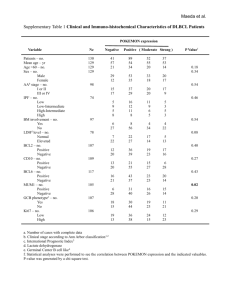


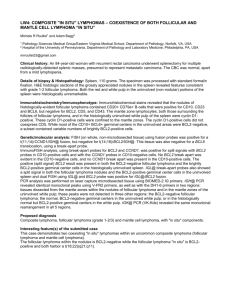
![Historical_politcal_background_(intro)[1]](http://s2.studylib.net/store/data/005222460_1-479b8dcb7799e13bea2e28f4fa4bf82a-300x300.png)


